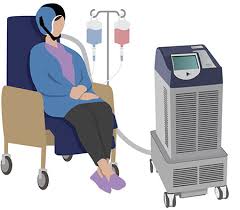Scalp cooling systems can assist individuals in maintaining some or a significant amount of hair during chemotherapy treatment, which can lead to hair loss.
- Every individual is born with a specific number of hair follicles, which cannot be changed.
- Each follicle has its own blood supply, which brings the necessary nutrition to the hair.
- Cooling the scalp shrinks those blood vessels, decreasing the amount of chemotherapy drugs that reach the hair follicles and thus decreasing the hair loss associated with chemotherapy.
- Chemo drugs act on rapidly growing cells, which include those at hair roots. This causes alopecia.
- Loss of hair occurs from the scalp as well as other areas like eyebrows, etc. Common drugs that cause hair loss/ hair thinning are:
- Adriamycin
- Cyclophosphamide
- Ifosfamide
- Taxol
- Hair loss affects the patient’s psychological well-being.
- Cooling caps are used for scalp cooling, which can be manual or machine-powered.
- Manual caps need to be replaced every 30 minutes or so.
- Machine-powered caps work continuously
- Scalp cooling should be started 20-50 mins prior to starting chemo.
- It should be continued during and after chemotherapy completion, the duration of which is determined by the drug given.
- Since the technique shrinks the blood vessels of the scalp, the delivery of drugs to the scalp vessels is inhibited. Thus, it is not advisable in haematological malignancies like leukaemia and lymphoma.
- It can be impractical to use to use:
- if the chemotherapy is given via infusion for a few days
- if the patient has already received a cycle of chemotherapy without scalp cooling
- if the liver function is deranged (the drugs can last in circulation for a longer period)
- Other uses (therapeutic hypothermia):
- Hypoxic ischemic encephalopathy
- Ischemic stroke
- Cardiac arrest
- The cap should touch the crown at all times. The chin straps are used for the tight grip of the cap.

